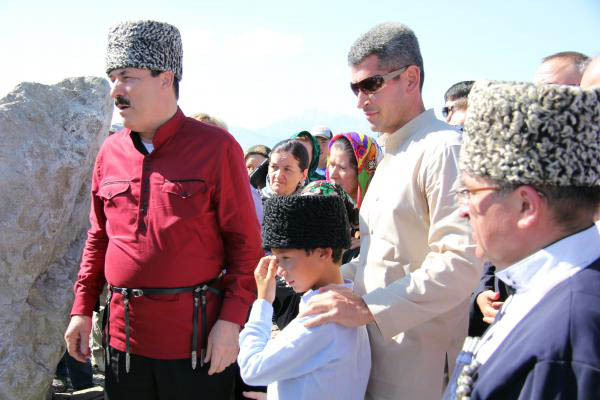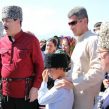
Avar Clans Gradually Take Over Governmental Posts in Dagestan
Publication: Eurasia Daily Monitor Volume: 12 Issue: 185
By:

Dagestan’s clans have experienced significant shifts after the republic’s political leadership changed in 2013, when Moscow dispatched Ramazan Abdulatipov to rule the territory. The politics in the republic have remained quite fluid despite the removal of many political heavyweights. “Dagestan is one of the few regions of Russia where political competition has survived,” wrote Dagestani analyst Musa Musaev. “Instead of political parties, however, the powerful informal ethnic and political groups compete with each other. Such groups share no ideological views or professional interests, just family ties, common origin and sub-regional identity.” These clans are often politically organized within certain parties. Several clans often share the same party affiliation. For example, all powerful clans have to have their “share” of representation in the ruling United Russia party, in order to compete for government resources (Riaderbent.ru, October 8).
With the rise of Ramazan Abdulatipov, an ethnic Avar, to power in Dagestan, ethnic Dargins became marginalized in the republic. Avars are the single largest ethnic group in the republic, comprising about a third of the population. The Dargins are the second largest ethnic group, with approximately 17 percent of the republic’s population. One of Dagestan’s most powerful and longest-lasting politicians, Said Amirov, who was mayor of Makhachkala and an ethnic Dargin, was arrested, flown out of the republic and sentenced to a lengthy prison term. The Dargins have dominated political life in the republic for most of the years since the demise of the Soviet Union in 1991.
The main beneficiaries of this “Dargin rule,” however, were not the Dargins as such, but very specific groups of Dargins from Levashi district in the mountains of Dagestan. Dargins who originated from the Levashi district villages of Mekegi, Jangamakhi, Tsudakhar and Kupa formed a tight elite group that ruled the republic for years. Now, clans from the Avar-populated Charoda, Tlyarata, and Khunzakh districts have the upper hand in Dagestan and are steadily taking over lucrative government positions. The takeover is happening despite the system of ethnic quotas in the republic, under which certain government positions are informally reserved for specific ethnic groups. In a recent example of this takeover, an Avar from Charoda district, Bilal Jabkharov, was appointed Dagestan’s finance minister, a position reserved for ethnic Dargins. Three Avar clans and two Dargin clans are currently competing for the position of Makhachkala mayor, which has control over substantial resources (Riaderbent.ru, October 8).
Changes are also taking place within the Avar elites. Two Avar districts, Gunib and Khunzakh, accounted for most of the members of Dagestan’s elite for decades after the Russian Empire’s conquest of the region in the 19th century. Gunib was at the center of the Dagestani resistance to the Russian conquest and the tsar’s government willingly co-opted local nobility in order to control the area. Khunzakh, the cradle of the Avar literary language, was an alternative Avar center. The most famous Dagestani poet, Rasul Gamzatov, came from Khunzakh. The Russian government supported Khunzakh to balance out the influence of Gunib, which was considered somewhat more rebellious. Interestingly, Khunzakh and Gunib enjoyed the status of Dagestan’s most favored districts throughout the Soviet era until the 1980s, when the Dargin clans started to take over. Only with Ramzan Abdulatipov’s arrival did the situation start to change, with the other Avar districts starting to catch up with the old Avar elites (Onkavkaz.com, October 6).
The shifts in Dagestan’s political elites have come with shifts in the financial sector. The best known Moscow-based Avar billionaire, Ziyaudin Magomedov, has predictably increased his presence in the republic. Magomedov hails from Khunzakh district and belongs to the republic’s old Avar elites. Magomedov’s investment group, Summa, started to receive large government contracts for infrastructure projects in Dagestan. Analysts discerned political ambitions in Magomedov’s activities after he engaged in flashy public actions, such as a meeting with Dagestan’s creative youth last September. On September 25, his 47th birthday, Magomedov erected a tent and spoke about innovations in Dagestan that would increase the republic’s competitiveness. Ramazan Abdulatipov appears to have given Magomedov’s action his blessing, as he was present at the meeting (Riaderbent.ru, October 8).
By contrast, the Moscow-based ethnically Lezgin billionaire Suleiman Kerimov, who is much wealthier than Magomedov, has relatively little presence in Dagestan. Kerimov’s son, 20-year-old Said, has made an ambitious offer to become the sole owner of Polyus Gold, Russia’s largest gold mining company, which is also one of the largest in the world. The current capitalization of the company is estimated at $8.7 billion (Onkavkaz.com, October 9).
The shifts within the Avar clans have not destabilized the republic. However, the non-Avar elites appear to be sidelined, and signs have emerged that Lezgins in southern Dagestan are increasingly unhappy with what they regard as essentially Avar rule of Dagestan, while the Dargins are also starting to gather forces to challenge the republic’s new status quo.




